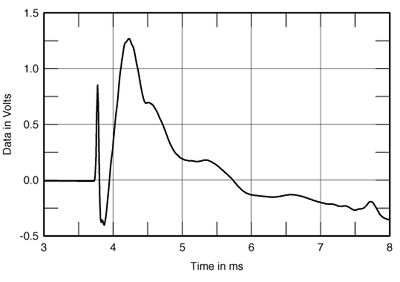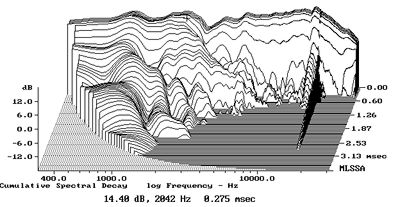| Columns Retired Columns & Blogs |
Merlin Music Systems VSM Millennium loudspeaker system Measurements part 3
In the vertical plane (fig.11), you can again see that the presence-region depression on the tweeter axis fills in on the optimal axis (third trace from bottom). But sit higher than the top of the enclosure and a large suckout centered on 2.4kHz develops in the crossover region. As always, don't listen to this speaker while standing.

Fig.11 Merlin VSM Millennium, vertical response family at 50", from back to front: differences in response 15 degrees-5 degrees above tweeter axis, reference response, differences in response 5 degrees-15 degrees below tweeter axis.
In the time domain, the Merlin's step response on the tweeter axis (fig.12) reveals that both drive-units are connected with the same positive acoustic polarity, with the tweeter output leading that of the woofer by about 0.5ms. Fig.13 shows the individual steps from the two units, again on the tweeter axis. Lowering the microphone to the design axis would have the effect of moving the woofer output (blue trace) very slightly forward in time, and that of the tweeter (red) very slightly back. While this would not be nearly enough to bring the two units into time alignment, the result would still be, as we have already seen in the frequency domain, better integration of the two units' outputs in the frequency domain.

Fig.12 Merlin VSM Millennium, step response at 50" on tweeter axis (5ms time window, 30kHz bandwidth).

Fig.13 Merlin VSM Millennium, step responses at 50" on tweeter axis of tweeter (red trace) and woofer (blue) (5ms time window, 30kHz bandwidth).
The woofer step in the above two graphs is overlaid by some slight ringing. This makes its presence known in the associated cumulative spectral-decay plot (fig.14) as a broad ridge of delayed energy at the top of the woofer passband. All things being equal, I would have expected this to add a slight nasality to the speaker's tonal signature. Although MF didn't comment on any coloration, I did notice what I felt was a very slight boxy nature to recorded piano when I auditioned the speaker in his system (before taking any measurements).

Fig.14 Merlin VSM Millennium, cumulative spectral-decay plot at 50" (0.15ms risetime).
But look at how quickly and cleanly the treble drops away in fig.14. (Ignore the ridge just below 16kHz, which is due to noise from my computer monitor being picked up by the measurement system.) It's no wonder that Merlin's VSM Millennium sounded so free of grain.—John Atkinson
- Log in or register to post comments




































